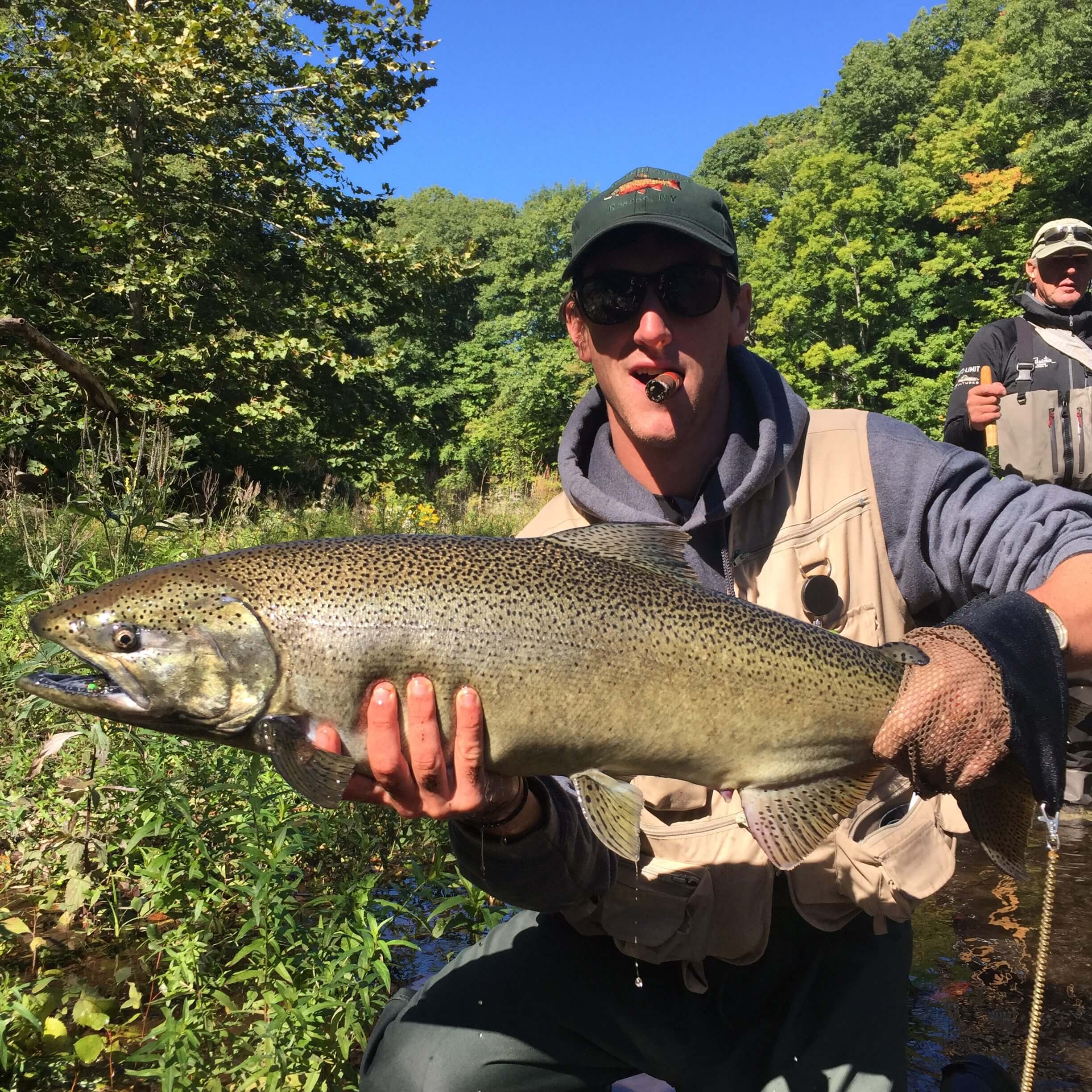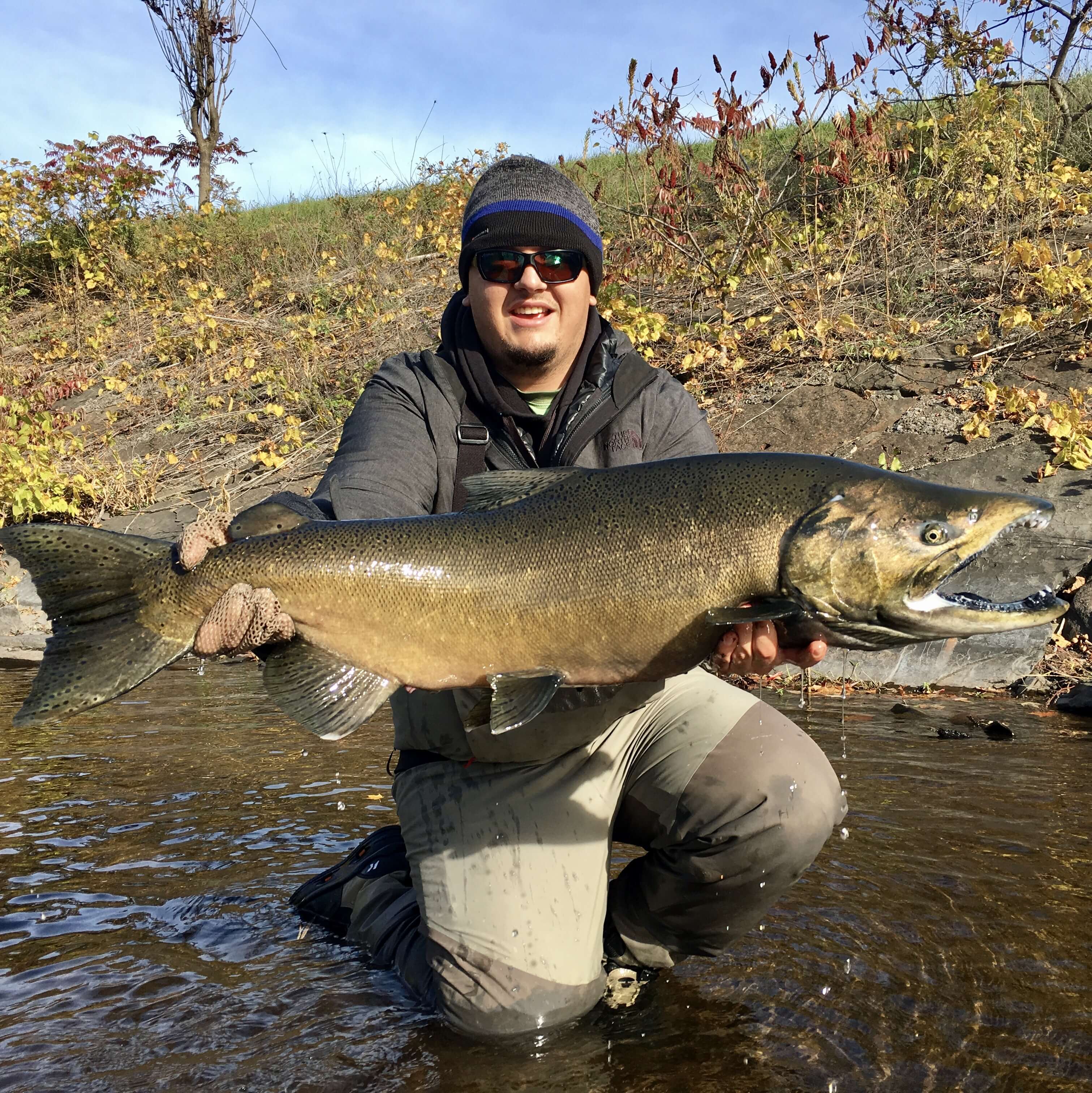Great Lakes King Salmon
Chinook Salmon
Chinook, or “King,” Salmon were first introduced into the Great Lakes water systems during the 1800’s following the near extinction of the Atlantic Salmon population in Lake Ontario. For centuries, legendary runs of Atlantic Salmon into the Tributaries of Lake Ontario supported growth of native populations in the New York and Canada regions, which spilled over to European settlement during the 1700 and 1800s. Despite plantings of 5 million fry and fingerlings from Lake Ontario stocks in 1866-84, the native Atlantic salmon in Lake Ontario became extinct in the late 1800’s primarily because tributaries in which they spawned were blocked by mill dams. For nearly a century, all attempted stocking efforts throughout the Great Lakes failed. It wasn’t until a major stocking movement from 1966-1970 in Lake Michigan of 13 million chinook salmon that a footprint began to form. From 1970 until present day, a small population of 12-15% of fish are through natural reproduction, but the majority of salmon in the Great Lakes are a direct result of State stocking efforts and wildlife management. Today, average King Salmon weight 18-25 pounds, with fish pushing over 30 pounds entering the rivers every year.Lifecycle:
Chinook Salmon hatch in late November through December and remain in the river for nearly a year. Once they smolt, the Salmon make their way down river into the Lakes and begin their aggressive growth. Over the course of the next two years, King Salmon will make an epic transformation from a 6-8” fry into a massive, 40-50,” 20-30 pound beast! Chinook Salmon will return to spawn typically once they hit three years of age, but are known to spawn at both two and four years in smaller numbers. Mature King Salmon begin to stage off tributary waters often in late-August to early-September, depending on a variety of factors such as weather, water flow and temperature, as well as the light cycle. Once in the rivers, King Salmon go through a massive physiological change and their sole purpose is to spawn. For a long time, it was believed Salmon stop feeding once they hit the river, but eating is engrained in their brain and is the only thing they know how to do. While not eating for nourishment per say, King Salmon continue to feed in the rivers mostly for territorial reasons and to eliminate competition in the watershed by eating eggs. The run will generally last throughout October and into November, often complete by Thanksgiving. However, in off years or different circumstances, “fresh” King Salmon can be caught even into late December!
Equipment:
Chinook Salmon are very large and powerful fish, often in excess of twenty pounds and very aggressive due to spawning conditions. While only at a fraction of their original strength, these King Salmon are still very powerful and quite aggressive when large numbers of fish enter the river. In order to combat these fish, a minimum of an 9’ 8wt. fly rod and large arbor reel are required to successfully fight and land these fish. Tapered leaders of the 0x-2x work best, depending on fishing technique and the conditions present, with tippet in the 8-12lb. range often able to handle even the most voracious fish. A large arbor reel is essential for an ample amount of line storage and the ability to rapidly retrieve said line when the fish turns and runs in the opposite direction. Often fly rods in the 11’-12’ range work best for larger waters such as the Salmon River and Oak Orchard River. The longer rod not only allows you to work with larger amounts of line of larger amounts of water, but almost helps when playing the fish! Ensure your reel is lined with plenty of 30lb braided backing, for some fresh Kings will try to run all the way back to the lake! For flies, I personally enjoy fishing with egg and baitfish imitations. These King Salmon are keyed into rival fish’s eggs and baitfish that might intrude on their territory, or “redds.” For days with excellent action, try adding a variety of flies into the mix. Remember, depending on where you fish in the river, these fish have often times seen the same presentation countless times, so switching up your presentation and offering can result in very successful days on the river while others are off shaking their heads!
Fishing Techniques:
Chinook Salmon are migratory fish, therefore, if you can find open water to fish, it is best to stay put throughout the day and let the fish move to you. The benefit of this is that its generally less strenuous throughout the day, the salmon you’re fishing for can be a fresh batch, and real estate on the river during the season can be few and far between. Typically, instead of tapered leaders, which often cost around ten bucks for a two pack, I make my own tapered leaders using amnesia and fluorocarbon fishing line. I break this up using a small, size 8-10, barrel swivel followed by 36”-48” of tippet. The tippet used is completely based on the fishing conditions, but generally its between 8-12lb. Any lower than 8lb tippet, the more real estate and confidence you’ll need to get that fish to the net! It’s possible, but certainly difficult to play a King Salmon effectively on anything smaller. Flies, again, are generally patterns that mimic eggs or small baitfish. Be sure to carry a variety of sizes and colors of each, and rotate flies regularly until you find what the fish are keyed in on. When the water is slightly stained or off color, chartreuse generally works best, while in clear conditions a more natural red, orange or pink presentation works best. Salmon generally tend to hold in the deeper sections of pools while migrating, and search for the best spawning ground to make their redd. Most often you can target these fish through sight-fishing and paying attention to shallow areas to catch salmon running through low riffles and moving up river. If you see salmon porpoising or rolling, these fish are often rising for unknown reasons, possibly due to the current and their large pectoral fins unexpectedly thrusting them up into the water column, but they aren’t rising for food and should therefore be ignored. Feeding salmon hold tight to the bottom and should be presented too at eye level in the water column. This takes some persistence and patience some days but aggressive salmon might move three or four feet to strike!



